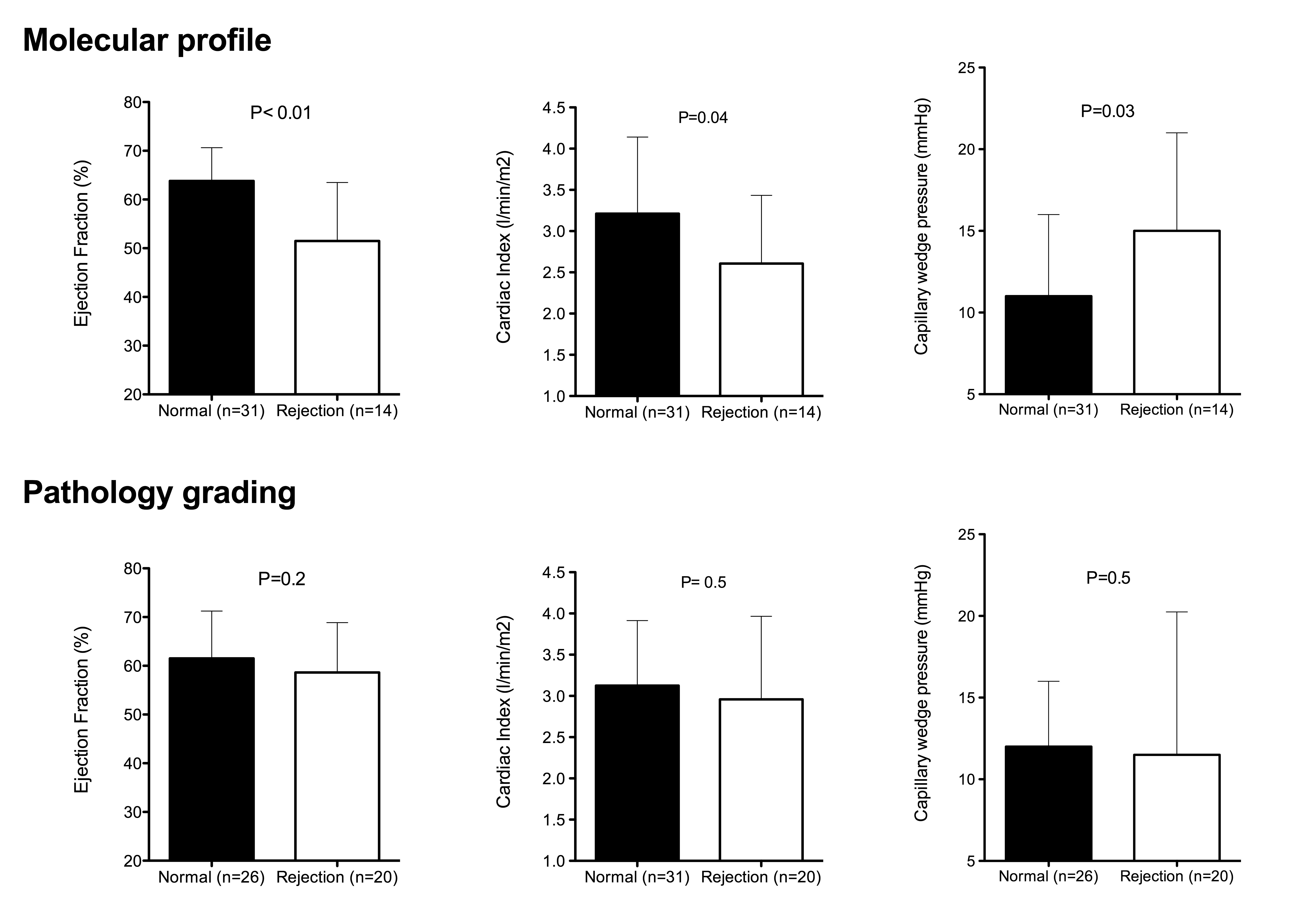Clinical Correlation of Endomyocardial Biopsies Molecular Profiling: Taking Rejection Diagnosis Beyond Histology.
1University of Bologna, Bologna, Italy
2Alberta Transplant Applied Genomics Centre, Edmonton, Canada
Meeting: 2017 American Transplant Congress
Abstract number: 221
Session Information
Session Name: Concurrent Session: Heart Transplantation: Antibodies and Outcomes
Session Type: Concurrent Session
Date: Monday, May 1, 2017
Session Time: 2:30pm-4:00pm
 Presentation Time: 2:54pm-3:06pm
Presentation Time: 2:54pm-3:06pm
Location: E271b
Histology grading of endomyocardial biopsies (EMB), the standard for diagnosing T-cell-mediated (TCMR) and antibody-mediated (ABMR) rejection, has serious issues with reproducibility (Transplantation 94 (11):1172177, 2012) and little correlation with function. To improve assessment of EMB, we adapted the Molecular Microscope Diagnostic System (MMDx) developed for kidney transplant biopsies (Nature Reviews Nephrology 12:534, 2016), and correlated the MMDx heart EMB findings with clinical phenotype in the prospective INTERHEART study (Clinicaltrials.gov NCT02670408).
We graded 46 EMBs from 35 patients by ISHLT criteria and blindly analyzed molecular rejection by expression of rejection-associated transcripts defined in kidney. Patients underwent right heart catheterization and cardiac ultrasound. To reduce data fragmentation, we simplified EMB histologic grades to normal vs. abnormal in both histology and in MMDx.
Based on MMDx findings, 14 EMBs (30%) showed molecular rejection (12 ABMR, 1 mixed and 1 TCMR). Compared to EMBs with no rejection, molecular rejection was associated with significant lower ejection fraction, lower cardiac index, and higher capillary wedge pressure (upper figure panes), and higher proportion of NYHA class ≥III (46 vs. 12%; P=0.02). Histologic TCMR or ABMR, found in 20 EMBs (43%), showed no correlation with clinical/hemodynamic phenotypes (lower figure panes). EMBs graded as no rejection by histology showed 92% concordance with molecular no rejection, but biopsies with histologic rejection showed only 50% with molecular rejection.  Thus rejection transcripts derived from kidney biopsies are expressed in EMBs and identify rejection, indicating that rejection mechanisms are stereotyped, not organ specific. Unlike histology, molecular rejection was significantly associated with cardiac graft dysfunction, suggesting that a molecular-based approach improves the diagnosis of rejection and will help to illuminate the grey areas of EMB histological grading.
Thus rejection transcripts derived from kidney biopsies are expressed in EMBs and identify rejection, indicating that rejection mechanisms are stereotyped, not organ specific. Unlike histology, molecular rejection was significantly associated with cardiac graft dysfunction, suggesting that a molecular-based approach improves the diagnosis of rejection and will help to illuminate the grey areas of EMB histological grading.
CITATION INFORMATION: Potena L, Borgese L, Gaudenzi A, Agostini V, Reeve J, Masetti M, Grigioni F, Leone O, Halloran P. Clinical Correlation of Endomyocardial Biopsies Molecular Profiling: Taking Rejection Diagnosis Beyond Histology. Am J Transplant. 2017;17 (suppl 3).
To cite this abstract in AMA style:
Potena L, Borgese L, Gaudenzi A, Agostini V, Reeve J, Masetti M, Grigioni F, Leone O, Halloran P. Clinical Correlation of Endomyocardial Biopsies Molecular Profiling: Taking Rejection Diagnosis Beyond Histology. [abstract]. Am J Transplant. 2017; 17 (suppl 3). https://atcmeetingabstracts.com/abstract/clinical-correlation-of-endomyocardial-biopsies-molecular-profiling-taking-rejection-diagnosis-beyond-histology/. Accessed December 23, 2025.« Back to 2017 American Transplant Congress
